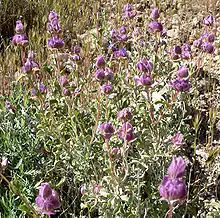Purple sage
Purple sage has various uses, mostly referring to plants.

One kind of "purple sage", Salvia dorrii
Plants
- From the title of Zane Grey's novel Riders of the Purple Sage, set in Utah. There is disagreement on what plant Grey referred to.
- Certain true sages, members of the genus Salvia in the mint family, are referred to as purple sage:
- Salvia dorrii, also called Ute tobacco sage, Dorr's sage, etc., which has showy purple flowers. It is a mild hallucinogen when smoked, and is used in Native American ceremonies and Native American herbal medicine. It is native to the western United States, including Utah, and has been identified as the plant Grey had in mind.[1]
- Salvia leucophylla, also called San Luis sage, likewise producing showy purple flowers, native to California and Baja California and used in xeriscaping in southern California.
- Salvia pachyphylla, called giant-flowered purple sage, blue sage, etc., a shrub native to California and bordering areas, used in xeriscaping in colder regions.
- Salvia officinalis "Purpurascens", the purplish-leaved variety (or group of varieties) of the common sage.
- Poliomintha incana, also called frosted sage, gray mint, etc., a small, pale-purple-flowered shrub of the mint family native to the southwestern U.S. and northern Mexico. It is found in the Colorado Plateau area of Utah[2] and has been identified as the plant Grey had in mind.[3]
- Leucophyllum frutescens, also called Texas sage, barometer bush, etc., a purple-flowered shrub of Texas (where it is the official state native shrub) and Mexico. Though it has been considered "the purple sage of cowboy song fame,"[4] it is not the plant of Grey's novel, as it is known in the U.S. only from Texas.[5]
- Psorothamnus scoparius, formerly Dalea scoparia and more often called broom dalea, a purple-flowered, nearly leafless shrub found in Texas, New Mexico, Arizona, and Mexico.
- Sagebrushes (Artemisia), loosely called sage, which are dominant plants in parts of Utah. They have been identified, tentatively[6] and definitely,[7] as the plant Grey had in mind. The purple color would be that of aerial perspective, as Grey mentioned:
- The sage about him was breast-high to his horse, oversweet with its warm, fragrant breath, gray where it waved to the light, darker where the wind left it still, and beyond the wonderful haze-purple lent by distance.[8]
Other uses
- Riders of the Purple Sage, a novel by Zane Grey, and several films based on the novel.
- Riders of the Purple Sage (band), a name used by three separate western bands in the United States
- New Riders of the Purple Sage, an American country rock band, or New Riders of the Purple Sage (album), their debut album
- Purple Sage, Wyoming, a census-designated place in Sweetwater County, Wyoming
- Open-source software for arithmetic geometry, closely related to SageMath.[9]
References
- Howard, Lynna (2000–2007). "What is Great Rift?". Archived from the original on 2008-09-07. Retrieved 2008-08-11.
- Van Buren, Renee; Cooper, Janet G.; Shultz, Leila M.; Harper, Kimball T. (2012). Woody Plants of Utah: A Field Guide with Identification Keys to Native and Naturalized Trees, Shrubs, Cacti, and Vines. University Press of Colorado. p. 333. ISBN 9780874218251. Retrieved 2019-09-26.CS1 maint: multiple names: authors list (link)
- Light, Kris H. (2005). "Purple Sage; Wild Rosemary Mint". Wildflowers. Retrieved 2019-09-26.
- "Leucophyllum frutescens - Greenbeampro". Branch-Smith Publishing. 26 January 1998. Archived from the original on 2008-06-13. Retrieved 2008-08-11.
- "PLANTS Profile for Leucophyllum frutescens (Texas barometer bush)". USDA PLANTS Database. USDA. NRCS. 2008. Retrieved 2008-08-11.
- Elmore, Francis H. (1976). Trees and Shrubs of the Southwest Uplands. Western National Parks Association. p. 71. ISBN 0-911408-41-X. Elmore specifically mentions Artemisia tridentata as a possibility for Grey's plant.
- Glattstein, Judy (2003). Consider the Leaf: Foliage in Garden Design. Timber Press. p. 111. ISBN 0-88192-571-3. Retrieved 2008-08-11.
Zane Grey purple sage sagebrush.
- Grey, Zane (1912). Riders of the Purple Sage. Grosset & Dunlap. p. 42. Retrieved 2008-08-11.
Riders of the Purple Sage.
- https://code.google.com/p/purplesage/
This article is issued from Wikipedia. The text is licensed under Creative Commons - Attribution - Sharealike. Additional terms may apply for the media files.